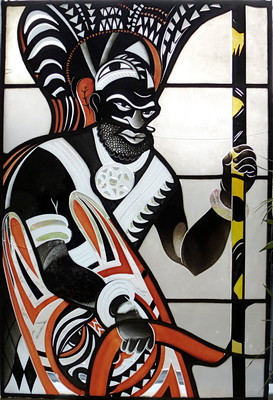Gottfried Heinersdorff (1883-1941)
Gottfried Heinersdorff is undoubtedly the most important personality in the development of modern glass-painting in Germany in the first quarter of the twentieth century, and may rightly be considered a reformer.
When his father died in 1900, the seventeen-year-old Gottfried took over the running of the workshop his father had established in Berlin-Schöneberg, which at that time already had a good name and was known across the country. In 1907, he became a founding member of the Deutscher Werkbund and had good connections with the leading modernist artists of the day, such as Henry van de Velde, Lyonel Feininger, Paul Scheerbart, Bruno Taut, and Johan Thorn Prikker, as well as with the artistic patron Karl Ernst Osthaus. Many expressionist artists were promoted by Heinersdorff, in so far as he commissioned designs from them, not just for windows, but also for mosaic floors, walls, and lamps. Max Peckstein, Adolf Hölzel, Josef Albers, and Cesar Klein worked with him, and their collaborations saw many large and small projects implemented. In inspiring the leading artists of the day in the field of glass-painting, he was able to promote the discipline to the same level as oil painting, bringing it recognition as an independent art form, even if only for a short time.
In 1914, Heinersdorff joined forces with the Deutsche Glas- und Mosaikgesellschaft Puhl & Wagner (Puhl & Wagner German Glass and Mosaic Association) based in Berlin-Rixdorf, which had been established in 1889 and promoted by Kaiser Wilhelm II, to create the Vereinigte Werkstätte für Mosaik und Glasmalerei Puhl & Wagner - Gottfried Heinersdorff (Puhl & Wagner / Gottfried Heinersdorff United Mosaic and Stained Glass Workshops). Puhl & Wagner was a protégé of the emperor, mainly because of the gold and silver smalts for which the firm had obtained an imperial patent in 1905. The windows and gold mosaics of the Kaiser-Wilhelm-Gedächtniskirche were especially well known. This joining of forces produced what for the time was the most innovative and progressive workshop in Germany.
The first collaborative project was the interior furnishing of the glass house by Bruno Taut at the Deutscher Werkbund exhibition in Cologne in 1914. In the same year, Heinersdorff’s ground-breaking Die Glasmalerei: ihre Technik und ihre Geschichte (‘Stained Glass: Its Technique and History’) was published by the Bruno Cassirer publishing house.
As far back as 1910, Heinersdorff had founded the Berliner Künstlerbund für Glasmalerei und Mosaik (Berlin Artists’ Association for Glass-painting and Mosaic), a group of architects and artists whose aim was to present modern trends in glass-painting to the public by means of exhibitions. Among those associated with this group were (for example) Peter Behrens, Albert Gessner, Cesar Klein, Max Pechstein, and Johan Thorn Prikker. In 1916, the firm was commissioned by Hermann Bahlsen to produce the glazing, to designs by Adolf Hölzel, for the boardroom of his factory building in Hannover. 1926 saw a fruitful collaboration between Heinersdorff and Josef Albers, and the rebuilding of the Grassi-Museum in Leipzig saw Heinersdorff working with two artists he rated highly, Josef Albers and Cesar Klein. Heinersdorff worked with Clemens Holzmeister between 1928 and 1930, executing important glazing schemes to designs by Heinrich Campendonk for Holzmeister’s projects.
From 1926 onwards, the differing artistic perceptions of the two partners, August Wagner and Gottfried Heinersdorff (the former conservative and faithful to the emperor, the latter an innovative reforming spirit), led to personal and commercial ruin; in order to rid himself of his partner, Wagner denounced Heinersdorff to the authorities as being of Jewish descent. Heinersdorff was forbidden to practise his profession and in 1935 was declared a half-Jew. He opened a photographic studio in Berlin and in 1937 was allowed to go to Paris to take part in an exhibition. He never returned to Germany, fleeing from the Nazis in 1940 to the Dordogne, where he died a broken man in 1941. The whereabouts of his grave in Mouleydier are not known.
Links
Gottfried Heinersdorff in WIKIPEDIA 


